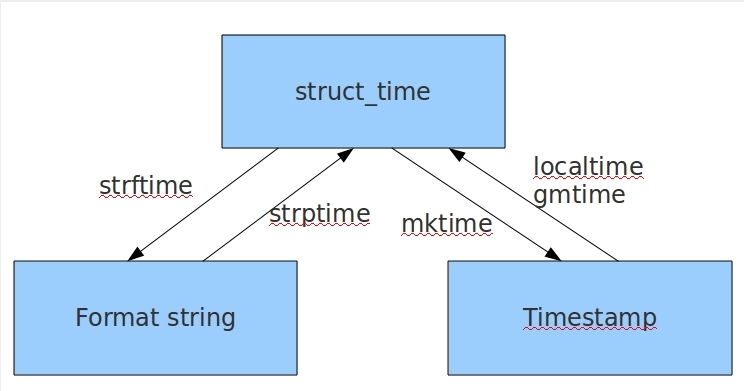一、time模块
三种格式
时间戳时间:浮点数 单位为秒
时间戳起始时间:
1970.1.1 0:0:0 英国伦敦时间
1970.1.1 8:0:0 我国(东8区)
结构化时间:元组(struct_time)
格式化时间:str数据类型的
1、常用方法
import time time.sleep(secs) 推迟指定的时间运行,单位是秒 for i in range(3): time.sleep(1) print(i)
2、表示时间的三种方式
时间戳(timestamp)、元组(struct_time)、格式化(str_time)的时间字符串 1. 时间戳(timestamp) :通常来说,时间戳表示的是从1970年1月1日00:00:00开始按秒计算的偏移量。 我们运行“type(time.time())”,返回的是float类型。 print(time.time()) # 1536050072.5732844(1970年1月1日00:00:00到此刻运行time.time()的时间) 2. 结构化时间(struct_time) :struct_time元组共有9个元素共九个元素:(年,月,日,时,分,秒,一周中第几天,一年中第几天,夏令时) struct_time = time.localtime() # 我国的时间 print(struct_time) # time.struct_time(tm_year=2018, tm_mon=9, tm_mday=4, tm_hour=16, tm_min=40, tm_sec=1, tm_wday=1, tm_yday=247, tm_isdst=0) struct_time = time.gmtime() # 伦敦的时间 print(struct_time) # time.struct_time(tm_year=2018, tm_mon=9, tm_mday=4, tm_hour=8, tm_min=40, tm_sec=1, tm_wday=1, tm_yday=247, tm_isdst=0) 3. 格式化时间(Format_string): fmt1 =time.strftime('%H:%M:%S') # 时分秒(全大写) fmt2 =time.strftime('%Y-%m-%d') # 年月日(年可大写可小写,月日小写) fmt3 =time.strftime('%y-%m-%d') # 年月日 fmt4 =time.strftime('%c') # 本地相应的日期表示和时间表示 print(fmt1) # 16:49:03 print(fmt2) # 2018-09-04 print(fmt3) # 18-09-04 print(fmt4) # Tue Sep 4 16:49:03 2018
3、几种时间格式间的转换

1. 转换
Timestamp ---> struct_time: time.localtime(转成我国的时间)、time.gmtime(转成伦敦时间)
struct_time ---> Timestamp: time.mktime()
Format_string ---> struct_time: time.strptime()
struct_time ---> Format_string: time.strftime()
2. 例子
1. 把格式化时间2018年8月8日转成时间戳时间 str_time = '2018-8-8' struct_time = time.strptime(str_time,'%Y-%m-%d') print(struct_time) # time.struct_time(tm_year=2018, tm_mon=8, tm_mday=8, tm_hour=0, tm_min=0, tm_sec=0, tm_wday=2, tm_yday=220, tm_isdst=-1) timestamp = time.mktime(struct_time) print(timestamp) # 1533657600.0 2. 把时间戳时间转成格式化时间 timestamp = 1500000000 struct_time = time.localtime(timestamp) str_time = time.strftime('%Y-%m-%d',struct_time) print(str_time) # 2017-07-14 3. 写函数,计算本月1号的时间戳时间 通过我拿到的这个时间,能迅速的知道我现在所在时间的年 月 def get_timestamp(): str_time = time.strftime('%Y-%m-1') struct_time = time.strptime(str_time,'%Y-%m-%d') timestamp = time.mktime(struct_time) return timestamp ret = get_timestamp() print(ret)

%y 两位数的年份表示(00-99) %Y 四位数的年份表示(0000-9999) %m 月份(01-12) %d 月内中的一天(0-31) %H 24小时制小时数(0-23) %I 12小时制小时数(01-12) %M 分钟数(00-59) %S 秒(00-59) %a 本地简化星期名称 %A 本地完整星期名称 %b 本地简化的月份名称 %B 本地完整的月份名称 %c 本地相应的日期表示和时间表示 %j 年内的一天(001-366) %p 本地A.M.或P.M.的等价符 %U 一年中的星期数(00-53)星期天为星期的开始 %w 星期(0-6),星期天为星期的开始 %W 一年中的星期数(00-53)星期一为星期的开始 %x 本地相应的日期表示 %X 本地相应的时间表示 %Z 当前时区的名称 %% %号本身
二、datetime模块
1、dateime.date
import datetime 1. datetime.date类型(年月日) 注意:datetime.date类型就是time模块的结构化时间,只是它在内部把结构化时间的显示格式化了再打印出来 datetime.date.today() # 2018-12-21 datetime.date(2018, 12, 21) # 2018-12-21 2.根据给定的时间戮,返回一个date对象<class 'datetime.date'> datetime.date.fromtimestamp(timestamp) # 返回一个date对象,与datetime.date.today()作用相同 datetime.date.fromtimestamp(1528345678) # 2018-06-07 3.由date日期格式转化为字符串格式 datetime.date.strftime(date对象, format) datetime.date.strftime(datetime.date(2018,12,20), '%Y-%m-%d') # 2018-12-20 是 str类型 datetime.date.today().strftime('%Y-%m-%d') # 2018-12-21 注意:date类型没有strptime
2、datetime.dateime
注意:datetime是继承了date的类 1. datetime.datetime类型(年月日时分秒微妙时区) datetime.datetime.today() # 2018-12-21 20:17:50.740914 datetime.datetime.now() # 2018-12-21 20:17:50.740914 datetime.datetime(2018, 12, 21, 8, 12, 8, 603000) # 2018-12-21 08:12:08.603000 返回当前日期时间的日期部分 datetime.datetime.today().date() # 2018-12-21 返回当前日期时间的时间部分 datetime.datetime.now().time() # 20:19:16.230449 2.根据给定的时间戮,返回一个datetime对象,<class 'datetime.datetime'> datetime.datetime.fromtimestamp() # 返回一个datetime对象,与datetime.datetime.today()作用相同 datetime.datetime.fromtimestamp(1528345678) # 2018-06-07 12:27:58 3. 由日期格式转化为字符串格式 datetime.datetime.strftime(datetime对象, format) datetime.datetime.strftime(datetime.datetime.now(), '%Y-%m-%d %H:%M:%S') # 2018-12-21 20:23:14 是str类型 datetime.datetime.now().strftime('%Y-%m-%d %H:%M:%S') # 2018-12-21 20:23:14 3.由字符串格式转化为日期格式 datetime.datetime.strptime(格式化时间, 时间格式) datetime.datetime.strptime('2018-12-21 21:01:27', '%Y-%m-%d %H:%M:%S') # 2018-12-21 21:01:27是datetime对象 4. 结构化时间:元组 注意:这就是结构化时间初始的样子 datetime.datetime.now().timetuple() # time.struct_time(tm_year=2018, tm_mon=12, tm_mday=21, tm_hour=20, tm_min=35, tm_sec=1, tm_wday=4, tm_yday=355, tm_isdst=-1)
3、datetime.timedelta
datetime.timedelta用于计算两个日期之间的差值 datetime.timedelta(weeks=1) # 返回一个时间差,参数weeks,days,hours,minutes,seconds [1 weeks=7 days],没有years,months 例1: import datetime day7 = datetime.timedelta(days=7) # 7天的时间时间隔 一年用52周表示 weeks=52 today = datetime.datetime.now() # 7天之后的时间是什么 # today + 7 after_7 = today + day7 print(after_7, type(after_7)) 例2: time1 = datetime.datetime(2018, 12, 20, 10, 24, 8) time2 = datetime.datetime(2017, 11, 12, 10, 24, 0) """计算天数差值""" print((time1 - time2).days) # 403 """计算两个日期之间相隔的秒数""" print((time1 - time2).seconds) # 8 print((time1 - time2).total_seconds()) # 34819208.0
4、datetime.time
time类有5个参数,datetime.time(hour,minute,second,microsecond,tzoninfo),返回08:29:30 1.datetime.time.replace() 2.datetime.time.strftime(format):按照format格式返回时间 3.datetime.time.tzname():返回时区名字 4.datetime.time.utcoffset():返回时区的时间偏移量
三、时间工具dateutil
直接看例子感受时间工具的绝对时间relativedelta吧
"""pip install python-dateutil""" from dateutil import relativedelta import datetime now = datetime.datetime.today() print(now) # 2018-12-21 20:37:31.005604 # 下个月 next_month = now + relativedelta.relativedelta(months=1) print(next_month) # 2019-01-21 20:37:31.005604 # 注意months和month的区别: # months=1 表示在现在的日期基础上加一个月的时间 # months=-1表示在现在的日期基础上减一个月 # month=1 表示把现在的日期的月份设置为1月 # years, months, days, weeks, hours, minutes, seconds等也是跟对应的year,month,day,week...一样 set_month = now + relativedelta.relativedelta(month=1) print(set_month) # 2018-01-21 20:37:31.005604(今天是12月21) # 注意与datetime.timedelta区别: # datetime.timedelta没有months和years参数 # 因此一个月用weeks=4表示,只能表示28天后,有偏差 next_month2 = now + datetime.timedelta(weeks=4) print(next_month2) # 2019-01-18 20:37:31.005604 # 下个月加一周 next_month_week = now + relativedelta.relativedelta(months=1, weeks=1) print(next_month_week) # 2019-01-28 20:37:31.005604 # 下个月加一周,上午10点 next_month_week_ten = now + relativedelta.relativedelta(months=1, weeks=1, hour=10) print(next_month_week_ten) # 2019-01-28 10:37:31.005604 # 一年后的前一个月 next_year_premonth = now + relativedelta.relativedelta(years=1, months=-1) print(next_year_premonth) # 2019-11-21 20:37:31.005604
